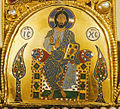Christogram

A Christogram (
One of the oldest Christograms is the
), using the first two letters of the name ΙΗΣΟΥΣ, 'JESUS' in uppercase.There were a very considerable number of variants of "Christograms" or monograms of Christ in use during the medieval period, with the boundary between specific monograms and mere
The name Jesus, spelt ΙΗΣΟΥΣ in Greek capitals, has the abbreviations IHS (also written JHS, IHC, or ΙΗΣ). The name Christus , spelt ΧΡΙΣΤΟΣ, has XP (and inflectional variants such as IX, XPO, XPS, XPI, XPM). In Eastern Christian tradition, the monogram ΙϹΧϹ (with Overline indicating scribal abbreviation) is used for Ἰησοῦς Χριστός in both Greek and Cyrillic tradition.
A
Symbols
Chi (Χ)
In antiquity, the
In Plato's Timaeus, it is explained that the two bands which form the "world soul" (anima mundi) cross each other like the letter Chi, possibly referring to the ecliptic crossing the celestial equator:
And thus the whole mixture out of which he cut these portions was all exhausted by him. This entire compound divided lengthways into two parts, which he joined to one another at the centre like the letter X, and bent them into a circular form, connecting them with themselves and each other at the point opposite to their original meeting-point; and, comprehending them in a uniform revolution upon the same axis, he made the one the outer and the other the inner circle.
— Plato, Timaeus, 8.36b and 8.36c[4]
The two great circles of the heavens, the equator and the ecliptic, which, by intersecting each other form a sort of recumbent chi and about which the whole dome of the starry heavens swings in a wondrous rhythm, became for the Christian eye a heavenly cross.
— Rahner 1971, pp. 49–50. See also Grigg 1977, p. 477
Justin Martyr in the 2nd century makes explicit reference to Plato's image in Timaeus in terms of a prefiguration of the Holy Cross.[5] An early statement may be the phrase in Didache, "sign of extension in heaven" (sēmeion epektaseōs en ouranōi).[3]
An alternative explanation of the intersecting celestial symbol has been advanced by George Latura, claiming that Plato's "visible god" in Timaeus is the intersection of the Milky Way and the Zodiacal Light, a rare apparition important to pagan beliefs. He said that Christian bishops reframed this as a Christian symbol.[6]
The most commonly encountered Christogram in English-speaking countries in modern times is the Χ (or more accurately, Chi), representing the first letter of the word Christ, in such abbreviations as
Chi Rho (ΧΡ)

The Alpha and Omega symbols may at times accompany the Chi-Rho monogram.[10] Since the 17th century, Chrismon (chrismum; also chrismos, chrismus) has been used as a Neo-Latin term for the Chi Rho monogram.
Because the chrismon was used as a kind of "invocation" at the beginning of documents of the
IHS

In the
The Greek letter iota is represented by 'I', and the eta by 'H', while the Greek letter sigma is either in its lunate form, represented by 'C', or its final form, represented by 'S'. Because the Latin-alphabet letters I and J were not systematically distinguished until the 17th century, "JHS" and "JHC" are equivalent to "IHS" and "IHC".
"IHS" is sometimes interpreted as meaning ΙΗΣΟΥΣ ΗΜΕΤΕΡΟΣ ΣΩΤΗΡ, Iēsous Hēmeteros Sōtēr, 'Jesus our Saviour' or in Latin Jesus Hominum (or Hierosolymae) Salvator, ('Jesus, Saviour of men [or: of Jerusalem]' in Latin)[16] or connected with In Hoc Signo. English-language interpretations of "IHS" have included "In His Service".[17] Such interpretations are known as backformed acronyms.
Used in Latin since the seventh century, the first use of IHS in an English document dates from the fourteenth century, in
The IHS monogram with the H surmounted by a cross above three nails and surrounded by a Sun is the emblem of the Jesuits, according to tradition introduced by Ignatius of Loyola in 1541.[16]
IHS has been known to appear on gravestones, especially among Irish Catholics.[19][20][21]
Gallery with different formats of the symbol
-
Medieval-style IHC monogram
-
Intertwined IHS monogram, Saint-Martin's Church, L'Isle-Adam, Val-d'Oise
-
IHC monogram from Clontuskert Abbey, Ireland
-
The Jesuit emblem from a 1586 print
-
Door at Church of the Good Shepherd (Rosemont, Pennsylvania) showing (from left) arms of the parish; Marian monogram; the IHS Christogram; and arms of the Episcopal Diocese of Pennsylvania
ICXC
In
On icons, this Christogram may be split: 'ΙϹ' on the left of the image and 'ΧϹ' on the right. It is sometimes rendered as 'ΙϹ ΧϹ ΝΙΚΑ' (Ἰησοῦς Χριστὸς νικᾷ), meaning 'Jesus Christ Conquers'. 'ΙϹΧϹ' may also be seen inscribed on the Ichthys.
-
Depiction of the 'ΙϹ ΧϹ ΝΙΚΑ' arrangement in medieval Greek tradition
-
Christ Pantocrator on the Holy Crown of Hungary (12th century)
-
Christ Pantocrator, Church of the Holy Sepulchre (1810)
Lhq

After
Archaeology
In 2016 a 1,300-year-old corpse, was found in a cemetery near a medieval monastery in Ghazali, Sudan, whose right foot bore a tattoo from medieval Nubia, a region that covered parts of modern-day Egypt and Sudan, depicting a Chi Rho and an Alpha Omega. The person, most likely male, lived sometime between 667 and 774.[24]
See also
- Christian symbolism
- Holy Name of Jesus
- INRI
- Little Sachet
- Names and titles of Jesus
- Nomina sacra
References
Notes
- ^ The portmanteau of Christo- and -gramma is modern, first introduced in German as Christogramm in the mid-18th century. Its adoption into English as Christogram dates to c. 1900.
- ^ While in English literature of the 19th to mid 20th century, chrismon refers to the Chi Rho monogram exclusively, the German-language usage has also come to be adopted in some cases in the specific context of medieval sigla, especially in works translated from German into English, e.g. Hans Belting, Edmund Jephcott (trans.), Likeness and Presence: A History of the Image Before the Era of Art (1997), pp. 107–109.[11]
Citations
- ^ Chrisimus (par les Bénédictins de St. Maur, 1733–1736), in: du Cange, et al., Glossarium mediae et infimae latinitatis, ed. augm., Niort : L. Favre, 1883‑1887, t. 2, col. 317b. "CHRISIMUS, Nomen Christi abbreviatum in antiquis instrumentis secundum diversos casus sic XPS. XPI. XPO. XPM. ubi media littera P. Græcum. Vox Chrisimus legitur in Annal. Benedict. tom. 5. pag. 7."
- ^ Crismon (par les Bénédictins de St. Maur, 1733–1736), in: du Cange, et al., Glossarium mediae et infimae latinitatis, ed. augm., Niort : L. Favre, 1883‑1887, t. 2, col. 621b. "CRISMON, Nota quæ in libro ex voluntate uniuscujusque ad aliquid notandum ponitur. Papias in MS. Bituric. Crismon vel Chrismon proprie est Monogramma Christi sic expressum ☧" 1 chrismon (par les Bénédictins de St. Maur, 1733–1736), in: du Cange, et al., Glossarium mediae et infimae latinitatis, ed. augm., Niort : L. Favre, 1883‑1887, t. 2, col. 318c, citing Heumann. de re Diplom. inde a Carol. M. § 12; Murator. Antiquit. Ital. tom. 3. col. 75.
- ^ JSTOR 3049702.
- ^ 8.36b and 8.36c
- ^ Justin. Apologia, 1.60.
- .
- ^ http://www.storiadimilano.it/cron/dal1651al1675.htm storiadimilano.it
- ^ I.12
- ^ I. A. Ferrai, "I Fonti di Landolfo Seniore", Bullettino dell'Istituto storico italiano 14 (1895), p. 29.
- ISBN 1-4426-1309-2page 137
- ^ For German usage, see Ersch et al., Volume 1, Issue 29 of Allgemeine Encyklopädie der Wissenschaften und Künste, 1837, p. 303 (in German). Johann Christoph Gatterer, Elementa artis diplomaticae universalis (1765), p. 145 ( Abriß der Diplomatik 1798, p. 64).
- ^ Johann Christoph Gatterer, Abriß der Diplomatik (1798), p. 64f. Carl Ernst Bohn, Allgemeine deutsche Bibliothek vol. 111 (1792), p. 521.
- ISBN 90-04-06247-5page 18
- ISBN 0-8264-1221-1page 54
- ^ "CATHOLIC ENCYCLOPEDIA: Holy Name of Jesus". New Advent.
- ^ a b Maere, René. "IHS." The Catholic Encyclopedia. Vol. 7. New York: Robert Appleton Company, 1910.
- ISBN 9780805963823.
- ^ "IHS". Oxford English Dictionary (Online ed.). Oxford University Press. (Subscription or participating institution membership required.)
- ^ Romano, Ron. Portland's Historic Eastern Cemetery: A Field of Ancient Graves. Arcadia Publishing. p. 87.
- ^ New Jersey Cemeteries and Tombstones: History in the Landscape. Rutgers University Press. 2008. p. 179.
- ^ Irish South Australia: New histories and insights. Wakefield Press. 2019. p. 81.
- ISBN 0-8028-4676-9page 67
- ^ JAANUS (2010) oribe dourou 織部灯籠, Japanese Architecture and Art Net Users System
- ^ Jarus, Owen (October 21, 2023). "'Christ' tattoo discovered on 1,300-year-old body in Sudan". Live Science. Archived from the original on October 24, 2023. Retrieved December 17, 2023.
Sources
- Rahner, Hugo (1971). Greek Myths and Christian Mystery. Translated by Brian Battershaw. Biblo & Tannen Publishers. ISBN 978-0-8196-0270-1.
External links
- St. Bernardine of Siena at the Library of Congress Web Archives (archived 2005-04-22)












